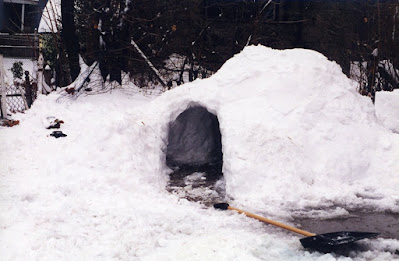Eskimo are a people of the Arctic. The Eskimos of Greenland and Canada are the Inuit and the Eskimos of eastern Siberia and Alaska are the Yupik.
The early Indians of North America lived in a number of different types of shelter. In the Far North, Inuits used three types of dwellings--tents of skin in the summer, huts of stone, turf, bones, and dirt in the winter, and snow igloos for the temporary shelter of winter hunting parties.
The Inughuit of northwest Greenland are the world's northernmost people. When contact was made in 1818 they had been isolated for several hundred years and were completely unaware of the existence of other humans.
According to a census in the 1920s, of 14,000 Inuits living in Greenland, only 300 had ever seen an igloo (see below).
It is a myth that the Inuit Eskimos have 50 words for snow. Whilst the Inuit did have about as many words for snow as the English, the Sami in Finland have in excess of fifty.
Although they live in a climate inhospitable to crop development, the Inuit do not suffer from vitamin C deficiency (scurvy) due to their diet of frozen and raw fish and mammal organs. By not cooking the food, the vitamin C is not broken down and can be absorbed by the human body.
There is a Canadian TV anchor who translates all the English news into Inuktitut live on air. Igalaaq is the only Inuktitut supper hour television in the whole country where unilingual Inuktitut speakers have this one chance, for 30 minutes, to see someone speaking their language.
The Inuit language doesn't have a word for freedom - the closest is "annakpok" which means "not caught".
The University of Calgary offers a two-day course in igloo building.
According to a census in the 1920s, of 14,000 Inuits living in Greenland, only 300 had ever seen an igloo (see below).
Although they live in a climate inhospitable to crop development, the Inuit do not suffer from vitamin C deficiency (scurvy) due to their diet of frozen and raw fish and mammal organs. By not cooking the food, the vitamin C is not broken down and can be absorbed by the human body.
There is a Canadian TV anchor who translates all the English news into Inuktitut live on air. Igalaaq is the only Inuktitut supper hour television in the whole country where unilingual Inuktitut speakers have this one chance, for 30 minutes, to see someone speaking their language.
The Inuit language doesn't have a word for freedom - the closest is "annakpok" which means "not caught".
The University of Calgary offers a two-day course in igloo building.
International Inuit Day is a holiday that was created to celebrate Inuit and amplify their voices. It falls on November 7.

No comments:
Post a Comment